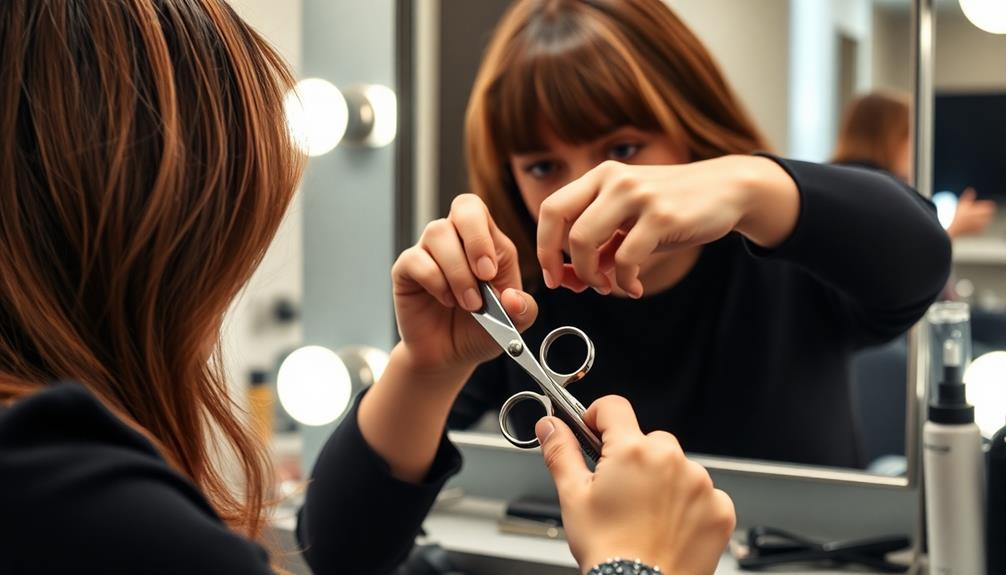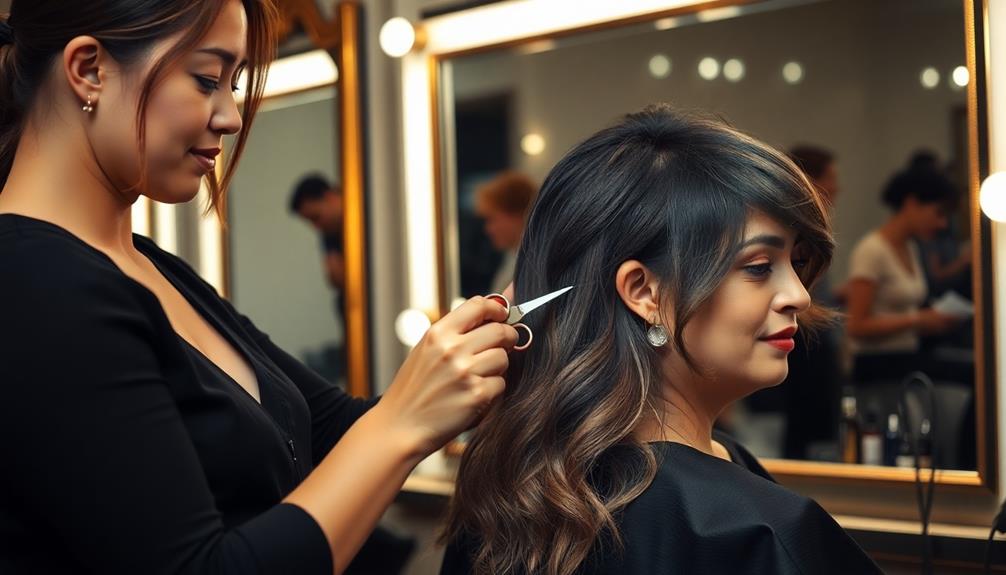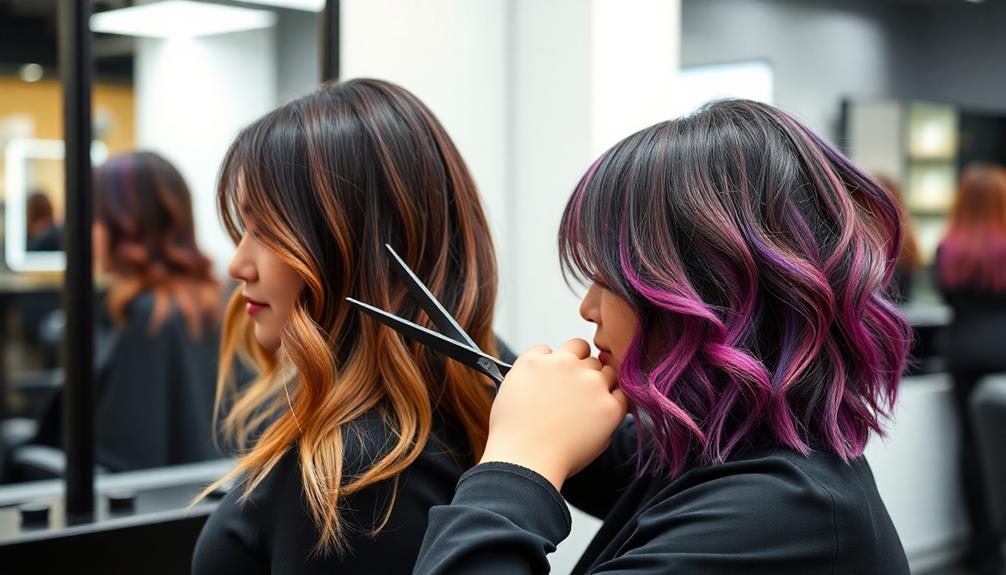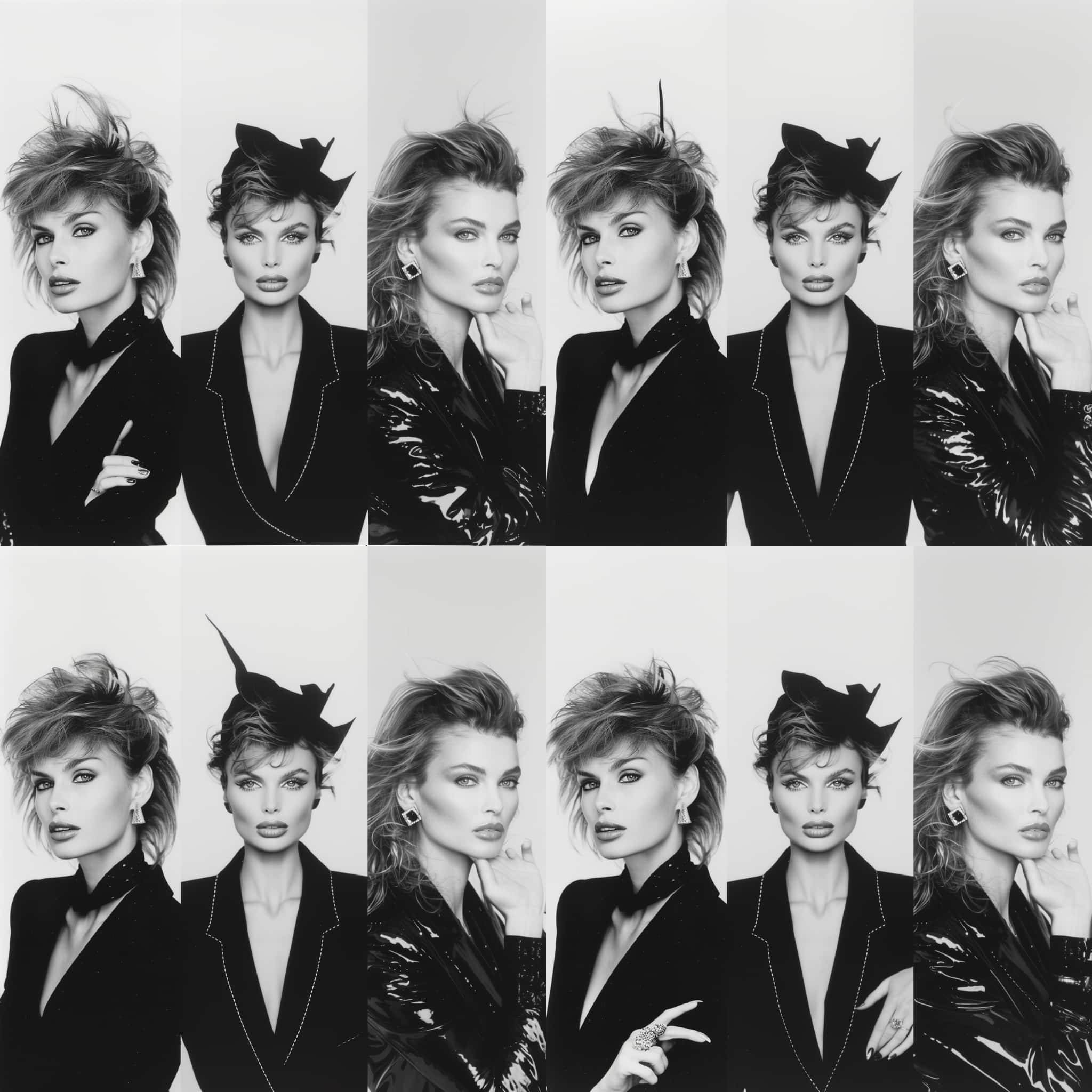If you want to master professional hair cutting techniques, it's important to understand layering and precision cuts. Start with elevation to shape your styles; higher lifts add volume, while lower cuts maintain weight. Over-direction helps control the shape, allowing you to soften or enhance facial features. Layering can bring movement and depth, while precision cuts offer sharp, clean lines. Don't forget the significance of texturizing for a natural finish. Each technique plays a crucial role in creating stunning haircuts tailored to your clients. You'll uncover even more insightful strategies as you explore further.
Key Takeaways
- Mastering elevation techniques, such as 90-degree angles, impacts hairstyle shape and enhances the client's natural features effectively.
- Over-direction allows for controlled manipulation of hair sections, influencing shape and weight balance in the final haircut.
- Layering methods, including horizontal and vertical cuts, significantly affect volume, movement, and overall haircut shape.
- Precision cutting techniques, like dry cutting and specific angles, improve versatility and control over the final hairstyle.
- Texturizing techniques, such as point cutting and thinning shears, enhance softness, reduce weight, and improve styling manageability.
Foundations of Hair Cutting

Mastering the foundations of hair cutting is essential for any stylist aiming to create tailored looks that meet client needs. To achieve precision cutting, you'll need to focus on key techniques like elevation, over-direction, and finger angles.
Elevation plays a fundamental role in controlling hair density; higher elevations add volume at the crown, while lower elevations maintain weight towards the ends. Additionally, incorporating essential oils such as peppermint oil can enhance the overall salon experience by promoting relaxation and invigorating the senses.
Over-direction is another foundational technique that helps you manipulate hair lengths and shapes. By moving sections forward or backward, you can dramatically affect the overall silhouette of the haircut. It's imperative to apply the right amount of tension between your fingers and the client's hair, ensuring stability and precision during the cutting process.
Proper sectioning is also critical. By using well-defined sections, you can maintain control over the hair and apply layering techniques effectively.
Whether you're executing horizontal or vertical cuts, these methods will enhance movement and texture in your finished look. As you refine your skills in these foundational areas, you'll find that your ability to create customized haircuts will greatly improve, meeting the unique needs of each client.
Elevation Techniques

Understanding elevation is key to shaping your haircut effectively.
By manipulating the angle at which you hold the hair, you can control both volume and weight distribution, tailoring the look to your client's needs.
Incorporating principles from Montessori toys can enhance your approach to creativity in hair cutting.
Let's explore techniques that will help you master elevation for stunning results.
Importance of Elevation
Elevation plays an essential role in haircutting, directly influencing the shape and density of your hairstyle. By adjusting the angles at which you hold the hair, you can create different effects.
Higher elevation techniques add volume and layers at the crown, giving your hair a fuller appearance. This is great for those looking to achieve a bouncy, textured look, similar to how farmhouse-style lighting fixtures can enhance the ambiance of a space.
On the other hand, using lower elevation techniques helps maintain weight toward the ends, resulting in a more blunt cut that feels structured and polished. This approach is particularly effective for clients who prefer a sleeker appearance.
Precise cutting with proper elevation allows you to frame the face better, enhancing your client's natural features and adjusting the overall silhouette.
Experimenting with various elevations can lead to unique styles tailored to individual preferences and hair types.
Ultimately, mastering elevation is vital for any stylist aiming to provide personalized, flattering haircuts. Whether you're creating soft layers or a bold blunt cut, understanding the importance of elevation will elevate your haircutting skills to new heights.
Techniques for Effective Elevation
Effective hair cutting relies heavily on the technique of elevation, which determines the overall shape and style of a haircut. Elevation refers to the angle at which you lift the hair. Higher elevation creates volume and density at the crown, while lower elevation maintains weight at the ends, resulting in a streamlined look.
To maintain the vibrancy of highlighted hair, consider using best shampoos for highlighted hair that are formulated to preserve color and shine.
To achieve precision, consistently maintain a 90-degree angle when layering. This guarantees smooth shifts and enhances the haircut's shape.
When working with curly or textured hair, adjust your elevation to preserve the natural curl pattern while achieving desired volume and shape.
Combining elevation techniques with over-direction gives you greater control over the silhouette. This approach allows you to enhance facial features effectively, guiding the eye to your client's best attributes.
Over-Direction Techniques

When you understand over-direction principles, you can control the shape and weight of your haircuts more effectively.
This technique not only influences elevation and weight balance but also enhances your ability to create styles that suit your client's features.
By mastering these principles, you can achieve a more dynamic look, similar to how high refresh rates improve gaming experiences for enthusiasts top projectors for gaming.
Let's explore how applying over-direction can elevate your cutting skills.
Understanding Over-Direction Principles
Over-direction is a fundamental technique that allows you to manipulate hair sections forward or backward along the head, giving you control over the length and weight of your haircut.
By applying over-direction in your hair cutting techniques, you can create stunning layers that enhance or soften facial features, depending on how you angle your cut.
It's vital to guarantee that your grooming tools are safe and free from allergens, similar to how you'd monitor dogs for any adverse reactions when introducing new foods like safe fruits for dogs.
Consider these key points when using over-direction:
- Density Control: Rotating sections toward the forehead increases density in the back, resulting in a voluminous look.
- Consistency: Maintain consistency by cutting hair as it naturally falls, which guarantees a balanced appearance.
- Silhouette Enhancement: Strategically using over-direction can greatly enhance the overall silhouette of a hairstyle, making it important for precision cutting.
Elevation and Weight Balance
Understanding how elevation influences weight balance in hair cutting can greatly enhance your results. Elevation refers to the height at which you hold hair while cutting. Higher elevations create volume and density at the crown, while lower elevations maintain weight towards the ends for a fuller finish.
This concept can be particularly essential for individuals with emotional dysregulation, as it mirrors the need for stability and control in their lives, similar to managing intense emotional responses. By mastering this technique, you can control the weight distribution throughout the cut.
Incorporating over-direction techniques allows you to move hair sections forward or backward, impacting the overall shape and balanced silhouettes of your haircut. This method is particularly effective for managing length and weight distribution in the back and sides.
When you consistently apply elevation and over-direction, you keep control over the final shape, ensuring professional results and avoiding unwanted bulk or unevenness.
These techniques also greatly influence the movement and texture of the hair. You'll notice that different elevations can enhance the haircut's visual impact, drawing attention to your client's facial features in a harmonious way.
Applications in Hair Cutting
In hair cutting, mastering over-direction techniques can greatly elevate your styling game. This technique involves moving sections of hair forward or backward relative to the head, allowing you to control the shape and weight distribution effectively.
By rotating hair sections toward the forehead, you can boost density in the back, creating a fuller look that many clients desire. Additionally, just as with choosing names for Rottweilers, a personal connection to the name can enhance the relationship with your clients, making them feel more involved in their hairstyle choices.
Here are some key benefits of using over-direction:
- Customized styles: Tailor haircuts to meet individual client preferences.
- Soft shapes: Create gentle lines that enhance overall aesthetics.
- Facial features: Adjust lengths to flatter diverse face shapes.
Maintaining consistency is vital when applying over-direction. Cut hair as it falls to guarantee a balanced appearance throughout the haircut.
This careful management of lengths and weights gives you the ability to craft styles that not only look great but also suit your clients' unique needs. Whether you aim for sharp precision or soft shapes, over-direction can transform your approach to hair cutting, leading to stunning results that highlight your skill and artistry.
Embrace these techniques, and watch your styling capabilities flourish!
Layering Methods

Layering methods are vital techniques that can transform a haircut, adding dimension and style. Horizontal layering involves cutting across sections of hair, creating layering effects that enhance volume and movement while maintaining a polished look. This method noticeably influences how your hair appears from front to back.
Additionally, the right products can enhance the styling process, ensuring your layers are defined and hold well, especially with options like pomades and gels for added texture (top hair products for men).
On the other hand, vertical layering focuses on adding length rather than texture. This technique allows for fullness and varying lengths when viewed from the front, helping achieve a more dynamic look.
When using vertical layering, maintaining consistency in weight distribution is critical. By working with smaller sections, you gain better control, ensuring an even finish that meets your client's expectations.
The choice between horizontal and vertical layering can dramatically affect the overall shape of a haircut, making it vital to evaluate desired outcomes and client preferences.
Ultimately, the right layering techniques can create a haircut that not only looks great but also suits the unique needs of your client. Whether you're aiming for a fuller, more textured style or a sleek, elongated look, mastering these layering methods will elevate your cutting skills.
Precision Cutting Techniques

Precision cutting techniques are essential for creating sharp, defined shapes and textures in hair. When you aim for a precision haircut, understanding specific angles and how they affect the overall look is critical. For instance, 90-degree cuts are perfect for layering, while 45-degree cuts work wonders for graduated bobs.
Additionally, exploring various styles can enhance your skill set, with options available even for those on a budget, such as affordable salon options.
To achieve ideal results, keep these key factors in mind:
- Effective Sectioning: Properly sectioning the hair allows you to manage it more easily and guarantees balance throughout the cut.
- Tension Control: Maintaining optimal tension between your fingers and the hair is essential for controlling the shape and texture of the final haircut.
- Advanced Techniques: Techniques like dry cutting and point cutting can enhance texture and movement, providing versatility in styling options.
Face-Framing Techniques

Creating a striking haircut goes beyond just precision cutting; face-framing techniques are key to highlighting your client's unique features. By strategically cutting hair around the face, you can enhance their natural beauty, ensuring a flattering and personalized look.
To achieve this, focus on layering that blends seamlessly into the overall hairstyle, avoiding bulk or holes that can disrupt the flow.
When employing face-framing techniques, consider the client's hair texture and face shape. Different fringe cutting methods—like blunt cuts or choppy layers—can provide the perfect complement to their features.
Proper sectioning is essential; it allows you to determine the right cutting angles for how the hair will fall. This attention to detail not only enhances movement but also contributes to overall balance.
Ultimately, tailoring these techniques to fit your client's style will greatly impact their satisfaction. By blending face-framing with thoughtful layering and precise cutting angles, you'll create a hairstyle that feels harmonious and personal.
Bang Cutting Techniques

Bangs can dramatically transform a hairstyle, framing the face and adding personality to your look. Mastering various bang cutting techniques is important to achieve the desired style based on your preferences and face shape.
Here are three popular styles to take into account:
- Blunt Bangs: These provide a bold, striking appearance and work well with straight hair.
- Choppy Bangs: This adds texture and movement, perfect for creating a more relaxed vibe.
- Side-Swept Bangs: These offer versatility and can soften your features.
When cutting bangs, it's essential to blend them seamlessly into the overall haircut. Techniques like point cutting help prevent harsh lines and create softer edges.
Understanding the client's desired length and density is crucial; this guarantees the final result meets their expectations for maintenance and styling.
Remember, regular trims are key to keeping your bangs fresh and in shape, preventing them from looking outdated or unkempt.
Texturizing Techniques

How can you elevate a haircut while maintaining its shape and style? Texturizing techniques are your answer. By using methods like point cutting and slicing, you can effectively remove bulk from the hair, adding dimension and movement without sacrificing the overall silhouette.
Point cutting involves cutting into the ends of the hair at an angle, creating soft edges that result in a more natural look. This technique reduces weight while keeping the length intact.
Slicing, on the other hand, requires sliding the shears along the hair shaft, giving a soft, feathery effect that adds lightness and volume.
Utilizing thinning shears can further enhance your texturizing efforts, blending layers seamlessly and preventing harsh lines that disrupt the flow of the haircut.
Proper texturizing not only improves the aesthetic but also makes styling more manageable, allowing for versatility in different looks. Plus, it can help reduce the appearance of split ends, making your hair look healthier overall.
Incorporating these techniques into your skill set will elevate your haircuts, ensuring your clients leave with styles that are both beautiful and easy to maintain.
Advanced Cutting Strategies

Building on your texturizing skills, advanced cutting strategies take your techniques to the next level, allowing you to craft sophisticated hairstyles that truly flatter your clients. These strategies include precise techniques like graduated bobs and pixie cuts, which require attention to detail to highlight facial features beautifully.
To enhance your skills, consider incorporating the following advanced methods:
- Layering methods: Use vertical layering for fullness and horizontal layering for added texture, giving your styles dimensionality.
- Tension techniques: Hold hair at an ideal distance between your fingers to control the final texture and shape of the haircut effectively.
- Specialized techniques: Employ point cutting and razor cutting to achieve softness and movement, creating versatile styles that look natural.
Additionally, implementing over-direction techniques allows you to manage the shape and balance of the haircut, enabling you to customize lengths and weights that suit your clients' features.
Frequently Asked Questions
What Is a Precision Cut Haircut?
A precision cut haircut's all about achieving clean lines and defined shapes. You'll notice exact angles and lengths, ensuring your hairstyle looks uniform and polished, enhancing your natural texture beautifully. Regular trims keep it looking fresh.
How Do You Section Your Hair With Precision and Accuracy?
Did you know that sectioning hair correctly can improve your cutting accuracy by up to 80%? To achieve precision, start at the nape, use 1-inch subsections, and always cross-check for symmetry.
What Are the Four Types of Haircuts?
You'll find four popular haircut types: blunt cuts for a sleek look, layered cuts for movement, textured cuts for dimension, and bangs for framing your face. Each offers a unique style to express yourself!
What Are the Proper Techniques for Layering the Hair?
To layer hair properly, you'll want to cut at different lengths, maintain a 90-degree elevation, and sub-section larger areas. Cross-check your work to verify accuracy and achieve a balanced, polished finish.
Conclusion
In the world of hair cutting, mastering these techniques can transform your skills and elevate your clients' looks. Did you know that 70% of clients feel more confident after a fresh cut? By incorporating elevation, layering, and precision techniques, you're not just cutting hair; you're crafting confidence. So, whether you're framing a face or adding texture, remember that each technique plays a crucial role in creating stunning styles that leave lasting impressions. Keep honing your craft!









